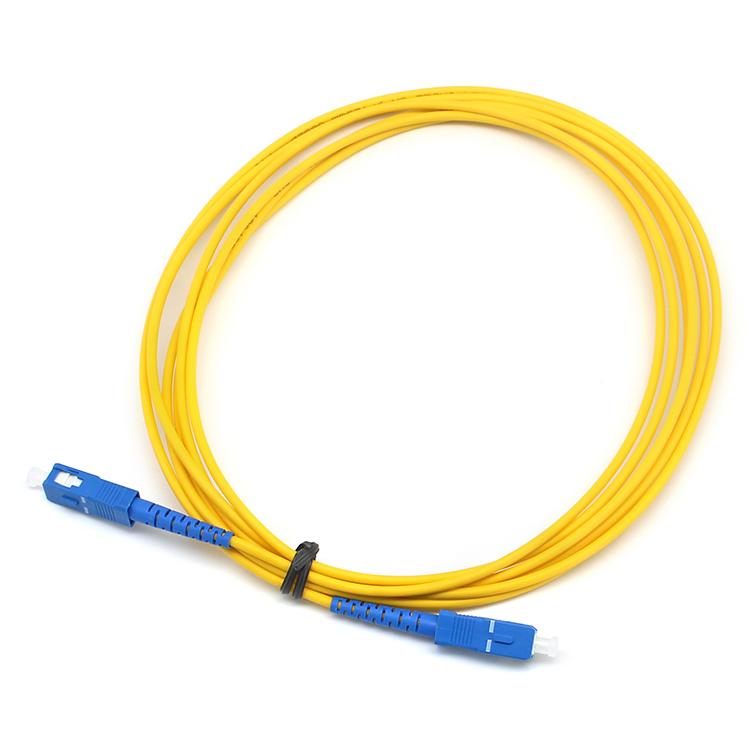
Fiber Optic Pigtail stands out in today’s networks like a superhero in a city of wires. Its superpower? Bending resistance! Even in cramped, tricky spaces, it never lets the signal fade. Check out the chart below—this cable handles tight turns and keeps data zipping along, no sweat!
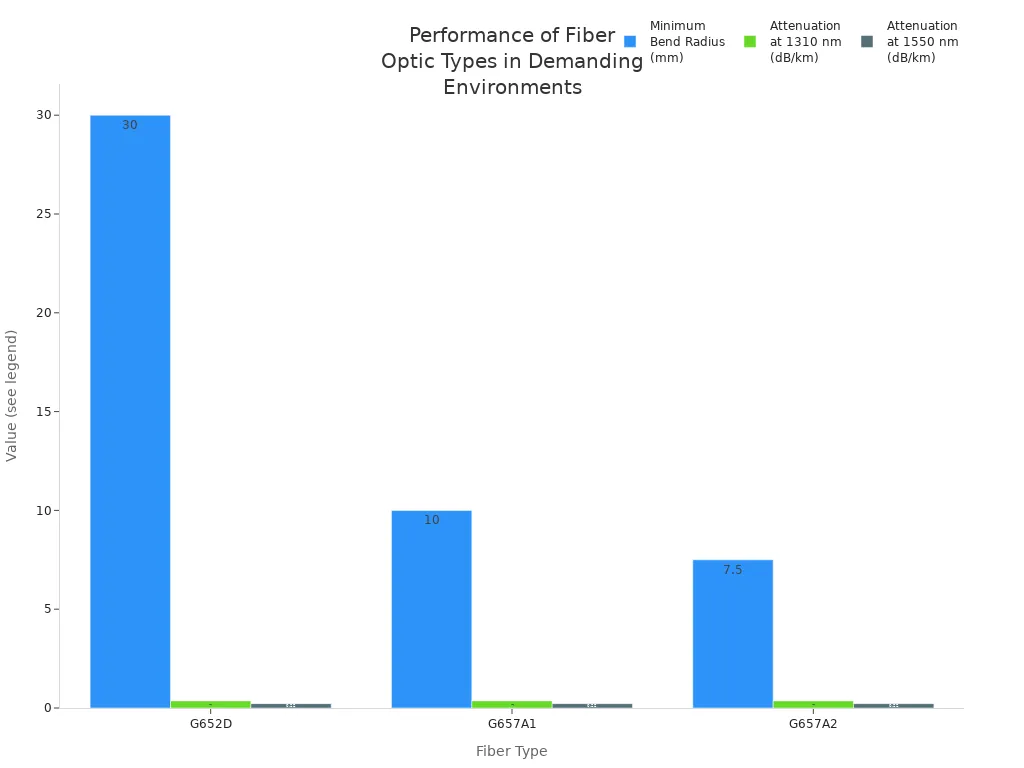
Key Takeaways
- Fiber Optic Pigtail bends easily in tight spaces without losing signal, making it perfect for homes, offices, and data centers.
- This cable keeps data strong with low signal loss and high return loss, ensuring fast and clear internet, TV, and phone connections.
- Its flexible design and broad connector options make installation simple, saving time and space while boosting network reliability.
Fiber Optic Pigtail Features and Advantages
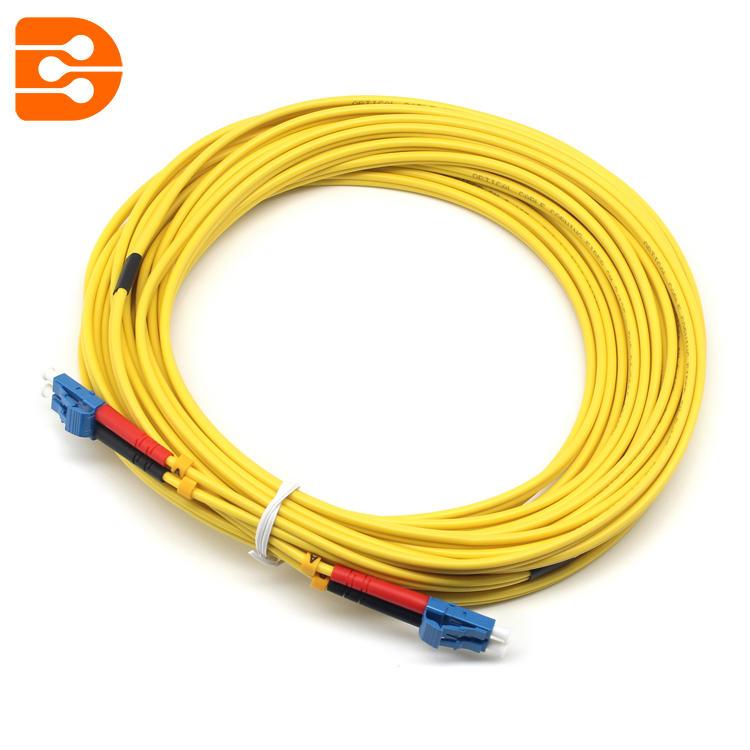
Superior Bending Resistance
Fiber Optic Pigtail loves a challenge. Tight corners? Twisty routes? No problem! This cable bends like a gymnast and keeps the signal strong. In places where other cables might lose their cool (and their data), this one stays sharp.
Imagine a cable that can twist and turn through a maze of furniture, walls, and racks—never dropping a beat. That’s the magic of advanced bend-insensitive fiber.
Check out this table showing how different fiber types handle bending:
| Feature | G652D Fiber | G657A1 Fiber | G657A2 Fiber | G657B3 Fiber |
|---|---|---|---|---|
| Minimum Bend Radius | 30 mm | 10 mm | 7.5 mm | 7.5 mm |
| Attenuation at 1310 nm | ≤0.36 dB/km | ≤0.36 dB/km | ≤0.36 dB/km | ≤0.34 dB/km |
| Attenuation at 1550 nm | ≤0.22 dB/km | ≤0.22 dB/km | ≤0.22 dB/km | ≤0.20 dB/km |
| Bend Insensitivity | Lower | Improved | Advanced | Ultra-low |
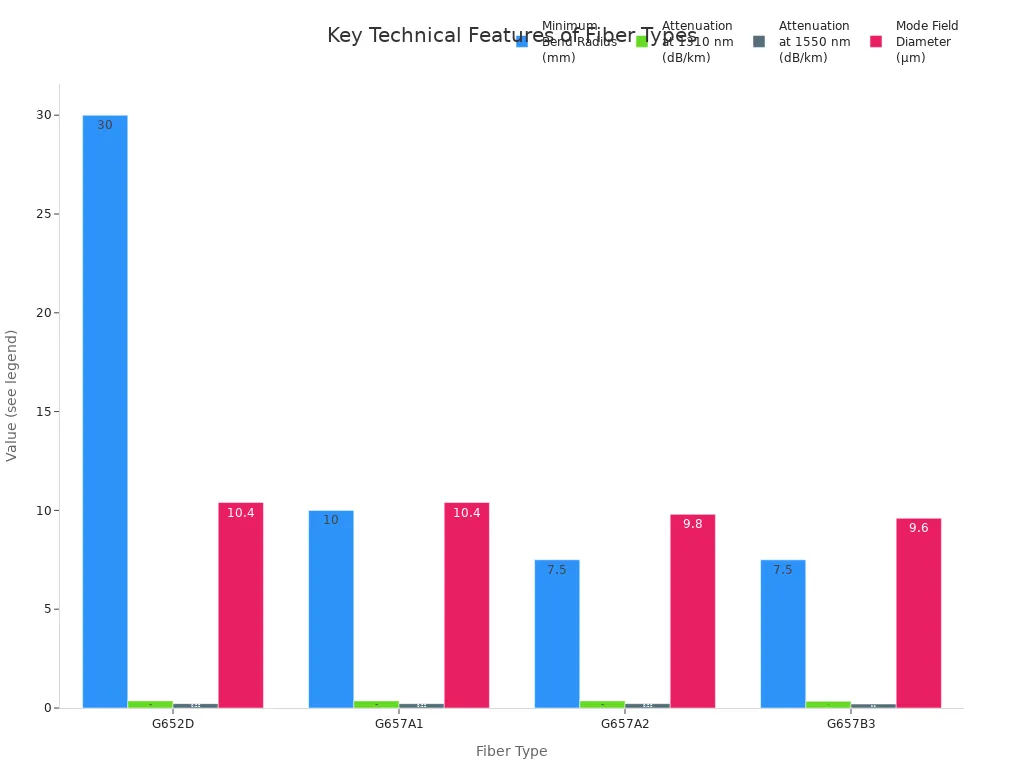
In real-world tests, this fiber type shrugs off bends that would make other cables cry. Even at a tiny 7.5 mm radius, it keeps signal loss to a minimum. That’s why installers love it for homes, offices, and data centers packed with gear.
Low Signal Loss and High Return Loss
Fiber Optic Pigtail doesn’t just bend—it delivers data with superhero precision. When signals travel through twists and turns, they stay strong.
- Low signal loss means your internet, TV, or phone calls don’t get fuzzy or slow.
- High return loss keeps unwanted echoes out of the network, so everything sounds and looks crystal clear.
Tests show that this fiber type handles tight bends with less signal loss than older cables. Even when squeezed into small spaces, it keeps the data flowing.
Network engineers say, “It’s like sending a message through a tunnel with no echoes and no traffic jams!”
Factory-Tested Quality Assurance
Every Fiber Optic Pigtail goes through a training camp before joining your network.
- The factory strips, trims, and cleans each cable.
- Epoxy gets mixed and connectors are attached with care.
- Machines polish the ends until they shine.
- Inspectors check for scratches, cracks, and dirt using video inspection.
- Each cable faces tests for signal loss and return loss.
- Packaging includes labels and performance data for easy tracking.
Quality control follows international standards, so every cable arrives ready for action.
- ISO 9001 certification means the factory takes quality seriously.
- Individual packaging keeps each cable safe and clean.
Broad Connector Compatibility
Fiber Optic Pigtail plays well with others.
- LC, SC, and ST connectors? All welcome!
- UPC and APC polish types? No problem.
- Single-mode fiber? Absolutely.
| Connector Type | Fiber Supported | Polish Types | Application Notes |
|---|---|---|---|
| LC | Single-mode G657 | UPC, APC | Telecom, WDM |
| SC | Single-mode G657 | UPC, APC | Equipment termination |
| ST | Single-mode G657 | APC | Specialized use cases |
Installers can pick the right connector for any job. Whether it’s a long-distance link or a crowded server rack, this cable adapts.
Tip: Choose the connector and length that fits your project. The cable’s flexibility and durability mean fewer headaches and lower costs.
Fiber Optic Pigtail brings speed, reliability, and flexibility to every network. It’s the cable that bends, connects, and performs—no matter where you put it.
Fiber Optic Pigtail Comparison with Other Fiber Types
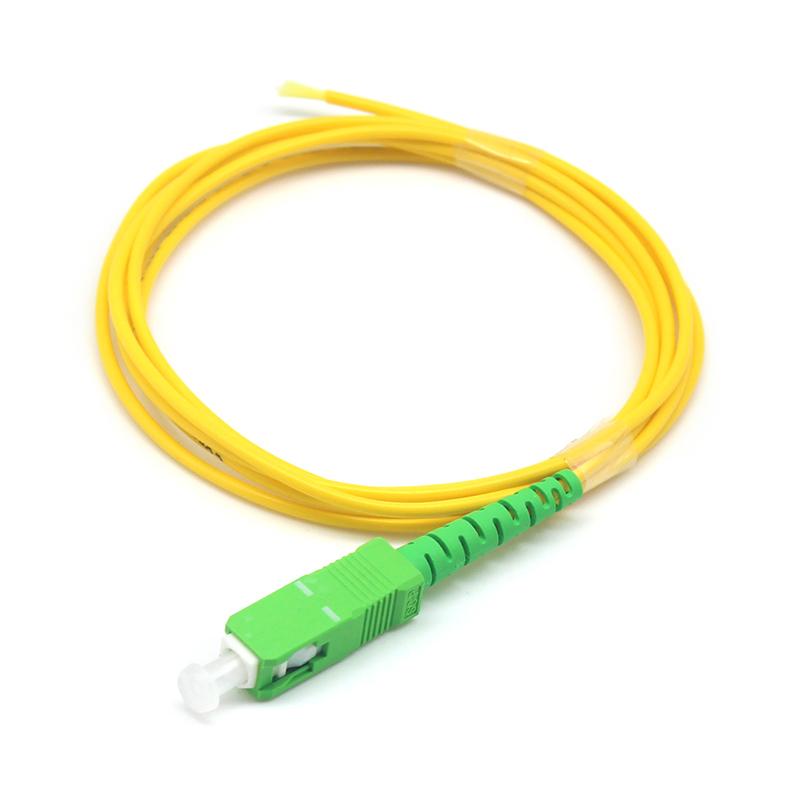
Bending Performance vs. Traditional Fibers
Fiber cables face a daily battle against tight corners and twisty routes. Some fibers break under pressure, while others keep the signal strong. The difference? Bending tolerance!
Let’s peek at how these fiber types stack up in the lab:
| Fiber Type | Bending Tolerance Class | Minimum Bend Radius (mm) | Bending Loss at 2.5 mm Radius (1550 nm) | Splice Compatibility with G.652.D | Typical Applications |
|---|---|---|---|---|---|
| G.652.D | N/A | >5 | >30 dB (very high loss) | Native | Traditional outside plant networks |
| G.657.A1 | A1 | ~5 | Very low (similar to G.652.D) | Seamless | General networks, short distance, low data rate |
| G.657.A2 | A2 | Tighter than A1 | Lower loss at tighter bends | Seamless | Central office, cabinets, building backbones |
| G.657.B3 | B3 | As low as 2.5 | Max 0.2 dB (minimal loss) | Often compliant with G.652.D core size | FTTH drop cables, in-building, tight spaces |
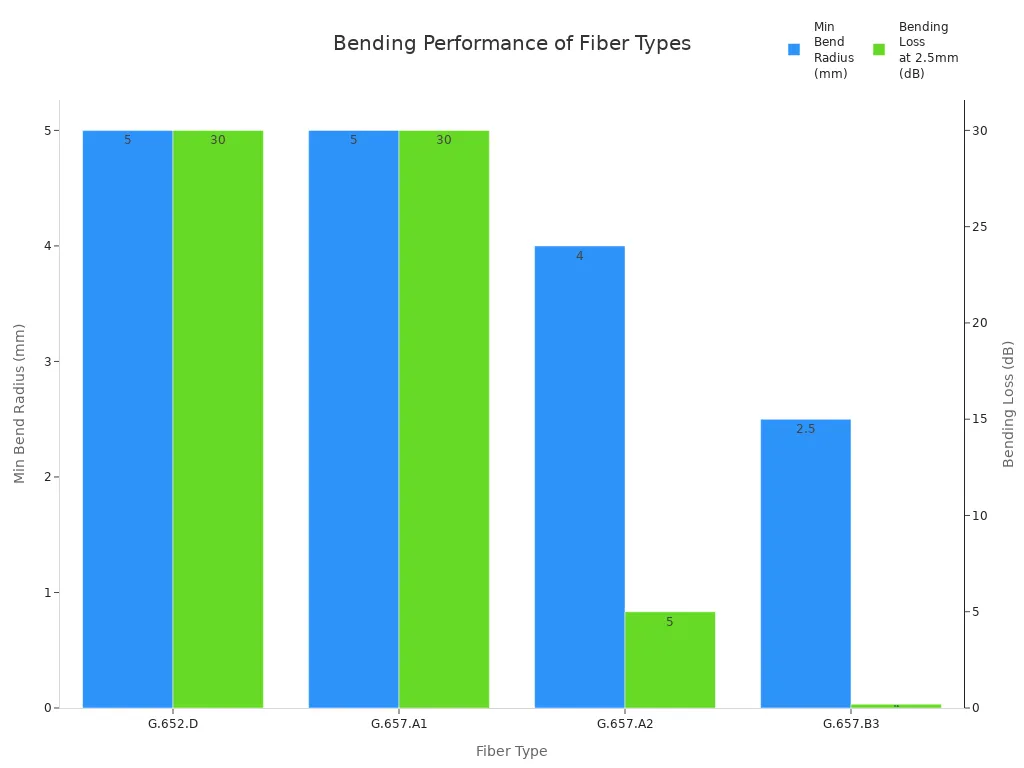
Traditional fibers like G.652.D need lots of room to stretch. They lose signal fast when squeezed into small spaces. Bend-insensitive fibers, on the other hand, handle tight bends with ease. In field deployments, the bend-insensitive design leads to fewer failures. One telecom giant saw failure rates drop from 50% to less than 5% after switching to bend-friendly fiber. That’s a win for reliability!
Installation Flexibility and Space Efficiency
Installers love a cable that bends and twists without breaking a sweat. Bend-insensitive fibers shine in tricky spots—behind walls, inside cabinets, and around sharp corners.
These cables feature a compact structure, often just 2-3mm in diameter. They slip through narrow pipes, cable trays, and tight building spaces.
- Last-mile connections to homes and businesses? Easy.
- Vertical and horizontal wiring in high-rise buildings? No problem.
- Replacing bulky cables in crowded trays? Piece of cake.
Bend-insensitive fibers reduce wiring complexity by up to 30%. They save up to 50% of space compared to older cables. Installers finish jobs faster and spend less time troubleshooting.
Tip: Smaller cables mean more room for other equipment. That’s a big deal in busy data centers and office buildings.
| Criteria | G.652.D Fiber | G.657.A1 Fiber | G.657.A2 Fiber |
|---|---|---|---|
| Minimum Bend Radius | ≥ 30 mm | ≥ 10 mm | ≥ 5 mm |
| Bending Loss (1 turn @ 10 mm radius) | High | ≤ 1.5 dB @ 1550 nm | ≤ 0.2 dB @ 1550 nm |
| Installation Flexibility | Low | Medium | Very High |
| Cost Level | Low | Medium | Slightly higher |
G.657.A2 fibers may cost a bit more upfront, but they save time and headaches during installation. Over time, lower maintenance and fewer failures make them a smart investment.
Performance in High-Density Environments
High-density networks look like spaghetti bowls—cables everywhere, packed tight. In these places, bend-insensitive fibers show their true colors.
- Minimum bend radii: 7.5 mm for A2 and B2, 5 mm for B3.
- Bend-insensitive fiber performance matters most in dense indoor setups, like 5G micro base stations.
- Optical loss from bending stays low, even when cables twist and turn.
Performance metrics for these fibers include:
- Insertion loss: typically ≤0.25 to 0.35 dB.
- Return loss: ≥55 dB (PC) and ≥60 dB (APC).
- Supported wavelengths: 1310 nm and 1550 nm.
- Mode Field Diameter (MFD): ensures efficient coupling and low network losses.
Fiber Optic Pigtail keeps signal integrity high, even in crowded racks. Its small diameter (around 1.2 mm) saves space. The design, with one connector end and a bare fiber for fusion splicing, allows precise connections with minimal loss.
Network engineers say, “It’s the secret weapon for high-density installations!”
- Bend-insensitive fibers outperform traditional types in tight spaces.
- They maintain low loss and high signal quality, even when packed together.
- Their flexibility and compact size make them perfect for modern, high-speed networks.
Fiber Optic Pigtail Applications
Home and Office Network Solutions
Picture a family streaming movies in every room or a busy office with dozens of laptops buzzing. Fiber Optic Pigtail steps in like a network superhero, making sure everyone gets fast, reliable internet. People use it for:
- Fiber to the Premise (FTTP) broadband
- Enterprise networks in tall buildings
- 5G network connections
- Long-haul and central office links
This pigtail bends around corners, squeezes behind desks, and hides in walls. It keeps the signal strong, even in tight spaces. Installers love how it fits into patch panels and telecom rooms, making upgrades a breeze.
Data Centers and Server Infrastructure
Data centers look like mazes of blinking lights and tangled cables. Here, Fiber Optic Pigtail shines. Its bend-insensitive design lets it snake through racks and cabinets without losing speed. Technicians use it for:
- High-precision fusion splicing
- Connecting servers and switches
- Building reliable backbones for enterprise networks
The pigtail’s flexibility means fewer cable failures and less downtime. Everyone in the data center cheers when the network runs smoothly!
CATV and Broadband Network Integration
Cable TV and broadband networks need strong, steady connections. Fiber Optic Pigtail delivers just that. Its tight bend radius and low signal loss make it perfect for:
| Benefit Aspect | Description |
|---|---|
| Improved Bending Performance | Handles tight bends, reducing signal loss |
| Deployment Flexibility | Fits in cabinets, enclosures, and crowded spaces |
| Suitability for FTTH and MDUs | Ideal for homes and multi-unit buildings |
| Network Integration | Works with existing broadband and CATV equipment |
Installers use these pigtails to connect optical network terminals, patch panels, and distribution frames. The result? Fast internet, clear TV, and happy customers.
Network experts cheer for this fiber pigtail’s unbeatable bend resistance, easy installation, and long-lasting performance. Check out the reasons it stands out:
| Advantage | Why It Matters |
|---|---|
| Super Flexibility | Fits tight spaces, fewer service calls |
| High Reliability | Handles thousands of bends, no worries |
| Future-Ready | Supports fast speeds and new tech |
Smart networks pick this cable for smooth upgrades and fewer headaches.
FAQ
What makes this fiber pigtail so bendy?
Picture a gymnast doing flips! Special glass lets the cable twist and turn without breaking a sweat. The signal keeps running, even around sharp corners.
Can I use this pigtail for my home internet upgrade?
Absolutely! Installers love it for homes, offices, and even secret lairs. It fits tight spaces and keeps your streaming fast and smooth.
How do I know the cable is high quality?
Every cable gets a superhero checkup—factory tests, video inspections, and careful packaging. Only the best make it to your network adventure!
Post time: Aug-14-2025
